The AMD Radeon R9 290X Review
by Ryan Smith on October 24, 2013 12:01 AM EST- Posted in
- GPUs
- AMD
- Radeon
- Hawaii
- Radeon 200
Company of Heroes 2
Our second benchmark in our benchmark suite is Relic Games’ Company of Heroes 2, the developer’s World War II Eastern Front themed RTS. For Company of Heroes 2 Relic was kind enough to put together a very strenuous built-in benchmark that was captured from one of the most demanding, snow-bound maps in the game, giving us a great look at CoH2’s performance at its worst. Consequently if a card can do well here then it should have no trouble throughout the rest of the game.
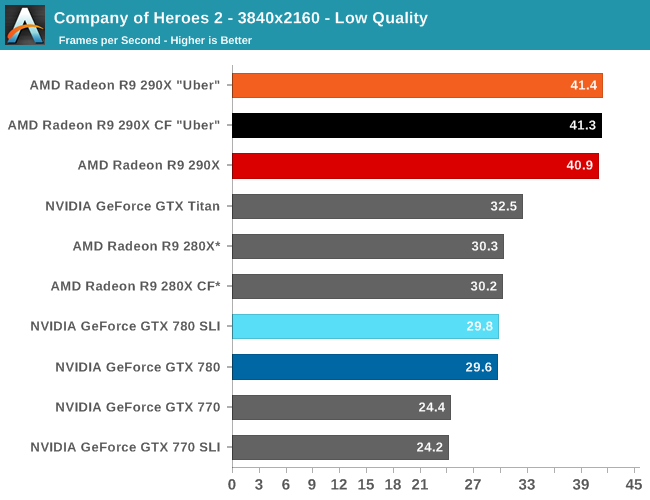
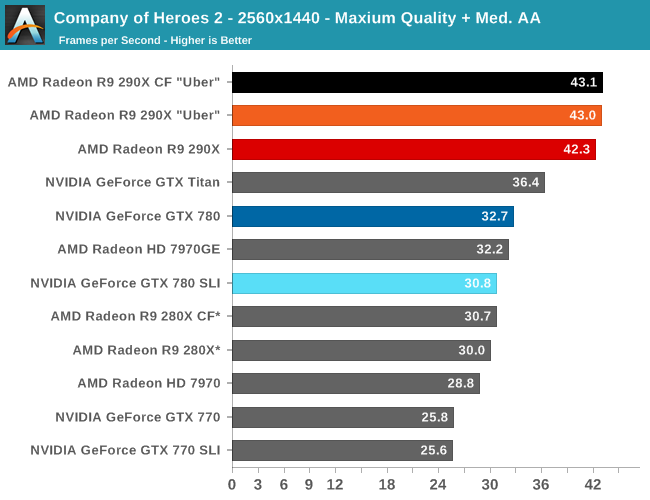
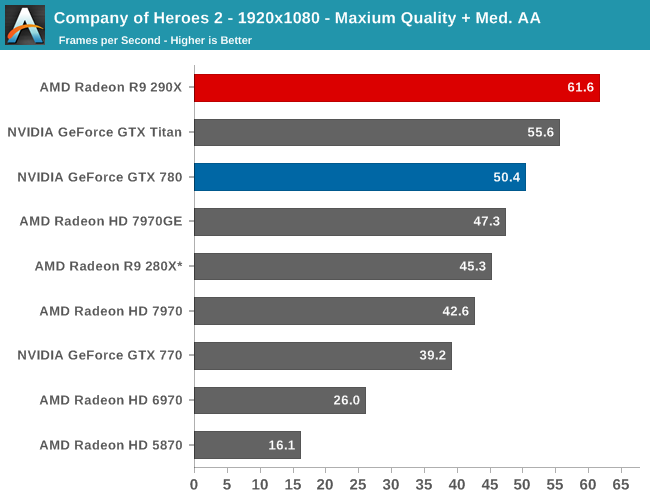
Our first strategy game is also our first game that is flat out AFR incompatible, and as a result the only way to get the best performance out of Company of Heroes 2 is with the fastest single-GPU card available. To that end this is a very clear victory for the 290X, and in fact will be the largest lead for the 290X of all of our benchmarks. At 2560 it’s a full 29% faster than the GTX 780, which all but puts the 290X in a class of its own. This game also shows some of the greatest gains for the 290X over the 280X, with the 290X surpassing its Tahti based predecessor by an equally chart topping 41%. It’s not clear what it is at this time that Company of Heroes 2 loves about 290X in particular, but as far as this game is concerned AMD has put together an architecture that maps well to the game’s needs.
Briefly, because of a lack of AFR compatibility 4K is only barely attainable with any kind of GPU setup. In fact we’re only throwing in the scale-less SLI/CF numbers to showcase that fact. We had to dial down our quality settings to Low on CoH2 in order to get a framerate above 30fps; even though we can be more liberal about playable framerates on strategy games, there still needs to be a cutoff for average framerates around that point. As a result 280X, GTX Titan, and 290X are the only cards to make that cutoff, with 290X being the clear winner. But the loss in quality to make 4K achievable is hardly worth the cost.
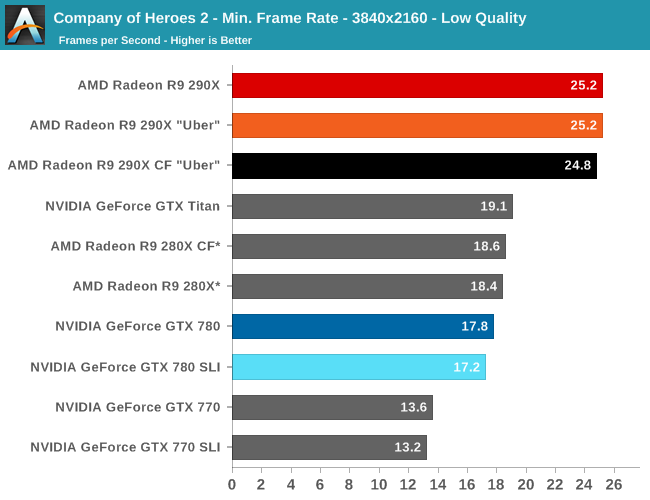
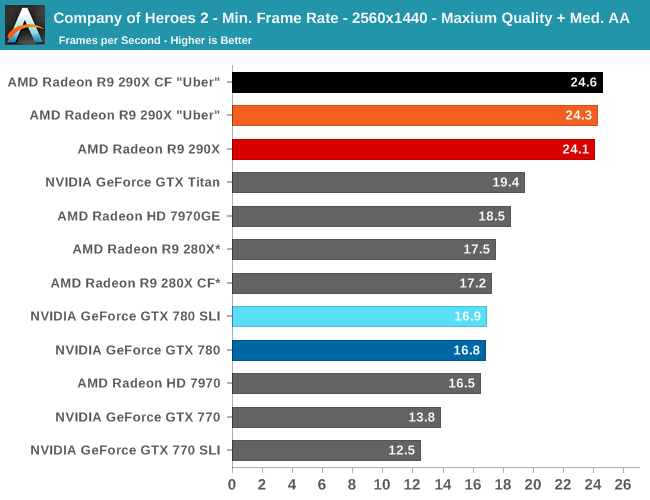

Moving on to minimum framerates, we see that at its most stressful points that nothing, not even 290X, can keep its minimums above 30fps. For a strategy game this is bearable, but we certainly wouldn’t mind more performance. AMD will be pleased though, as their performance advantage over the GTX 780 is only further extended here; a 29% average performance advantage becomes a 43% minimum performance advantage at 2560.
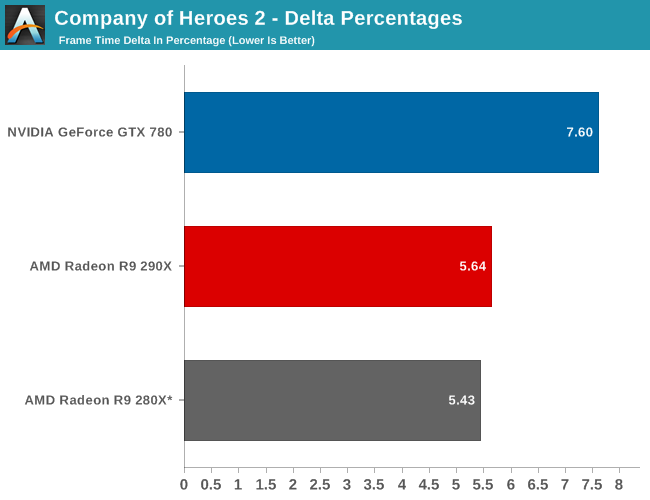
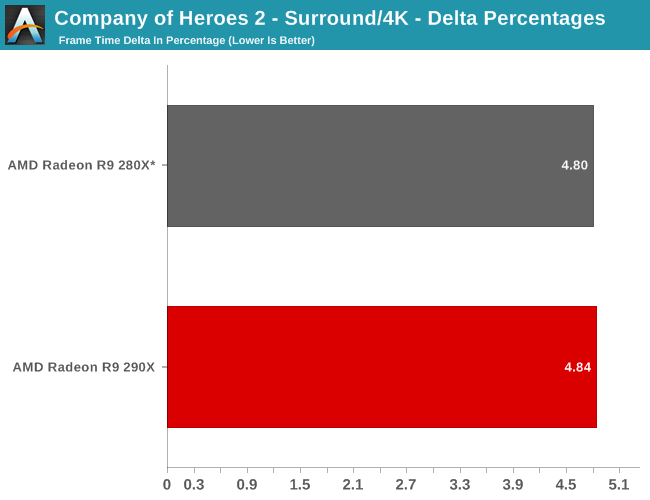
Finally, while we don’t see any performance advantages from AFR on this game we did run our FCAT benchmarks anyhow to quickly capture the delta percentages. Company of Heroes 2 has a higher than average variance even among single cards, which results in deltas being above 5%. The difference between 5% and 7% is not going to be too significant in practice here, but along with AMD’s performance advantage they do have slightly more consistent frame times than the GTX 780. Though in both the case of the 280X and the 290X we’re looking at what are essentially the same deltas, so while the 290X improves on framerates versus the 280X, it doesn’t bring with it any improvements in frame time consistency.










396 Comments
View All Comments
TheJian - Friday, October 25, 2013 - link
Incorrect. Part of the point of gsync is when you can do 200fps in a particular part of the game they can crank up detail and USE the power you have completely rather than making the whole game for say 60fps etc. Then when all kinds of crap is happening on screen (50 guys shooting each other etc) they can drop the graphics detail down some to keep things smooth. Gsync isn't JUST frame rate. You apparently didn't read the anandtech live blog eh? You get your cake and can eat it too (stutter free, no tearing, smooth and extra power used when you have it available).MADDER1 - Friday, October 25, 2013 - link
If Gsync drops the detail to maintain fps like you said, then you're really not getting the detail you thought you set. How is that having your cake and eating it too?Cellar Door - Friday, October 25, 2013 - link
How so? If Mantle gets 760gtx performance in BF4 from a 260X ..will you switch then?Animalosity - Sunday, October 27, 2013 - link
No. You are sadly mistaken sir.Antiflash - Thursday, October 24, 2013 - link
I've usually prefer Nvidia Cards, but they have it well deserved when decided to price GK110 to the stratosphere just "because they can" and had no competition. That's poor way to treat your customers and taking advantage of fanboys. Full implementation of Tesla and Fermi were always priced around $500. Pricing Keppler GK110 at $650+ was stupid. It's silicon after all, you should get more performance for the same price each year. Not more performance at a premium price as Nvidia tried to do this generation. AMD is not doing anything extraordinary here they are just not following nvidia price gouging practices and $550 is their GPU at historical market prices for their flagship GPU. We would not have been having this discussion if Nvidia had done the same with GK110.inighthawki - Thursday, October 24, 2013 - link
" It's silicon after all, you should get more performance for the same price each year"So R&D costs come from where, exactly? Not sure why people always forget that there is actual R&D that goes into these types of products, it's not just some $5 just of plastic and silicon + some labor and manufacturing costs. Like when they break down phones and tablets and calculate costs they never account for this. As if their engineers are basically just selecting components on newegg and plugging them together.
jecastejon - Thursday, October 24, 2013 - link
R&D. Is R&D tied only to a specific Nvidia card? AMD as others also invest a lot in R&D with every product generation, even if they are not successful. Nvidia will have to do a reality cheek with their pricing and be loyal to their fans and the market. Today's advantages don't last for to long.Antiflash - Thursday, October 24, 2013 - link
NVIDIA's logic. Kepler refresh: 30% more performance => 100% increase in priceAMD's logic. GCN refresh: is 30% more preformance => 0% increase in price
I can't see how this is justified by R&D of just a greedy company squishing its more loyal customer base.
Antiflash - Thursday, October 24, 2013 - link
Just for clarification. price comparison between cards at its introduction comparing NVIDIA's 680 vs Titan and AMD's 7970 vs 290xTheJian - Friday, October 25, 2013 - link
AMD way=ZERO PROFITS company going broke, debt high, 6Bil losses in 10yrsNV way=500-800mil profits per year so you can keep your drivers working.
Your love of AMD's pricing is dumb. They are broke. They have sold nearly everything they have or had, fabs, land, all that is left is the company itself and IP.
AMD should have priced this card at $650 period. Also note, NV hasn't made as much money as 2007 for 6 years. They are not gouging you or they would make MORE than before in 2007 right? Intel, Apple, MS are gouging you as they all make more now than then (2007 was pretty much highs for a lot of companies, down since). People like you make me want to vomit as you just are KILLING AMD, which in turn will eventually cost me dearly buying NV cards as they will be the only ones with real power in the next few years. AMD already gave up the cpu race. How much longer you think they can fund the gpu race with no profits? 200mil owed to GF in Dec 31, so the meager profit they made last Q and any they might have made next Q is GONE. They won't make 200mil profit next Q...LOL. Thanks to people like you asking for LOW pricing and free games.
You don't even understand you are ANTI-AMD...LOL. Your crap logic is killing them (and making NV get 300mil less profit than 2007). The war is hurting them both. I'd rather have AMD making 500mil and NV making 1B than what we get now AMD at ZERO and NV at 550mil.